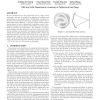Free Online Productivity Tools
i2Speak
i2Symbol
i2OCR
iTex2Img
iWeb2Print
iWeb2Shot
i2Type
iPdf2Split
iPdf2Merge
i2Bopomofo
i2Arabic
i2Style
i2Image
i2PDF
iLatex2Rtf
Sci2ools
DATE
2006
IEEE
2006
IEEE
Lens aberration aware timing-driven placement
Process variations due to lens aberrations are to a large extent systematic, and can be modeled for purposes of analyses and optimizations in the design phase. Traditionally, variations induced by lens aberrations have been considered random due to their small extent. However, as process margins reduce, and as improvements in reticle enhancement techniques control variations due to other sources with increased efficacy, lens aberrationinduced variations gain importance. For example, our experiments indicate that lens aberration can result in up to 8% variation in cell delay. In this paper, we propose an aberration-aware timing-driven analytical placement approach that accounts for aberration-induced variations during placement. Our approach minimizes the design’s cycle time and prevents hold-time violations under systematic aberration-induced variations. On average, the proposed placement technique reduces cycle time by ∼ 5% at the cost of ∼ 2% increase in wirelength.
Aberration-induced Variations | DATE 2006 | Hardware | Lens Aberration | Lens Aberrationinduced Variations |
| Added | 10 Jun 2010 |
| Updated | 10 Jun 2010 |
| Type | Conference |
| Year | 2006 |
| Where | DATE |
| Authors | Andrew B. Kahng, Chul-Hong Park, Puneet Sharma, Qinke Wang |
Comments (0)

